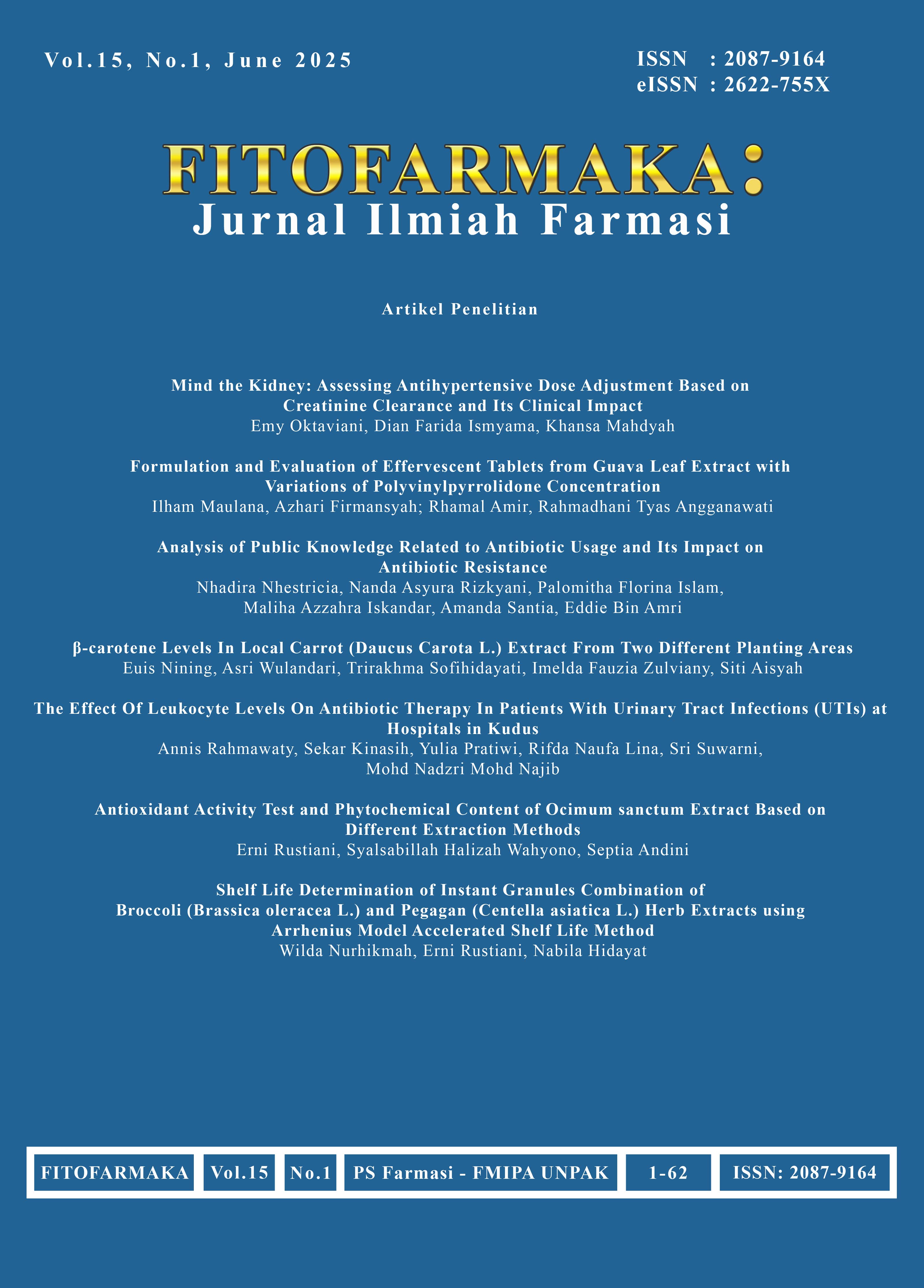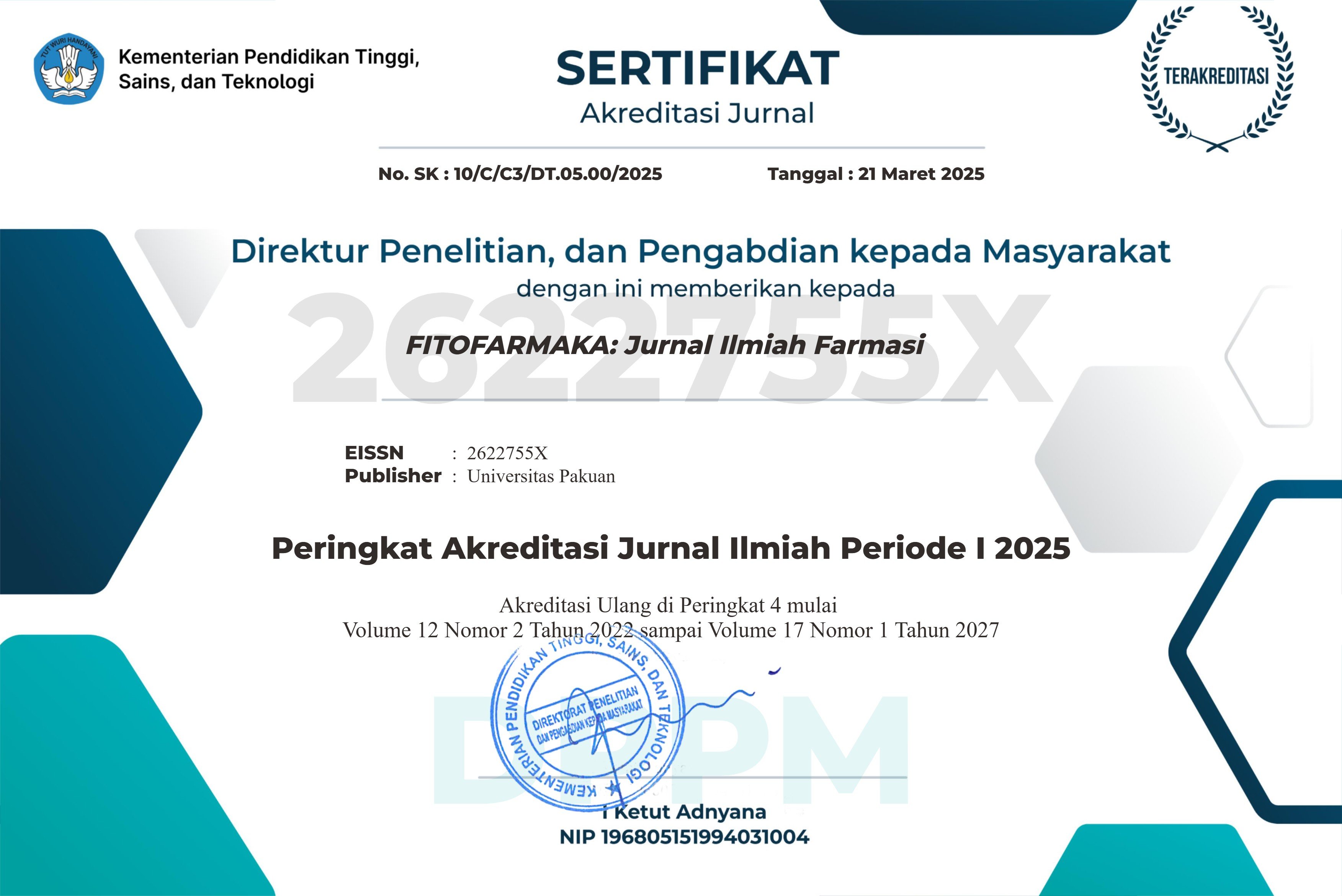β-carotene Levels In Local Carrot (Daucus Carota L.) Extract From Two Different Planting Areas
Keywords:
carrots, β-carotene, maceration, TLC, visible spectrophotometryAbstract
Carrots or Daucus carota L. are vegetables that have many benefits. β-carotene as the main content in carrots can act as provitamin A, antioxidants, and skin and facial care. Two types of local carrots, namely carrots grown in Citeko, Bogor Regency and Sukatani, Cianjur Regency, have the potential to be developed as a source of natural β-carotene for drug and cosmetic preparations. Determination of β-carotene levels in local carrots needs to be done before being used as drug and cosmetic preparations. The purpose of this study was to determine the β-carotene levels in the extracts of two types of local carrots, namely carrots from Citeko, Bogor Regency and Sukatani, Cianjur Regency. The sample powder was extracted by the maceration method using n-hexane solvent (1:10). Qualitative β-carotene testing was carried out by the TLC method using a silica gel 60 F254 stationary phase and a petroleum ether: benzene mobile phase (9:1). Determination of β-carotene levels using a validated method, namely the visible light spectrophotometry method with n-hexane solvent at a wavelength of 450 nm. The results of this study indicate that the β-carotene levels in Citeko carrot extract are 86.94 ± 5.53 mg/g and 104.09 ± 4.21 mg/g for Sukatani carrot extract. Based on the results of the ANOVA test, the β-carotene levels in the two types of carrot extracts did not show significant differences. Both types of local carrot extracts, Citeko and Sukatani, have the potential as sources of β-carotene for drug and cosmetic preparations.
References
Agustina, A., Hidayati, N., & Susanti, P. (2019). Penetapan Kadar β-Karoten pada Wortel (Daucus carota, L) Mentah dan Wortel Rebus dengan Spektrofotometri Visibel. JFSP, I, 2579–4558. https://doi.org/10.31603/pharmacy.v5i1.2293
AOAC. (2023). Guidelines for Standard Method Performance Requirements. https://doi.org/10.1093/9780197610145.005.006
Ashokrao, M. R., Nehete, J. Y., & Ghuge, A. D. (2022). Development and validation of UV Spectrophotometric method for estimation of β-carotene in Cissus quadrangularis stem extract. International Journal of Innovative Research in Technology, 9(3), 659–665.
Basuony, S. B., Khater, K. A. A., Hassanin, A. M., & Soliman, T. Nour. (2022). Production and characterization of nanodispersions of β-Carotene extracted from carrot waste and incorporated in functional processed cheese. Egyptian Journal of Dairy Science, 49–60. https://doi.org/10.21608/ejds.2022.165032.1006
Chandra, B., Zulharmita, & Handayani, A. D. H. (2017a). Analisis Kandungan Beta Karoten pada Daun Bayam Merah (Amaranthus hybridus L.) dengan Metode Spektrofotometri Visibel. Jurnal Farmasi Higea, 9(2), 149–158.
Cornelia, M., & Nathania, C. (2020). Pemanfaatan Ekstrak Wortel (Daucus carota L.) dan Sari Kiwi Kuning (Actinidia deliciosa) dalam Pembuatan Permen Jeli. Fast-Jurnal Sains Dan Teknologi, 4(2), 31–45.
Dewi, B., & Wirahmi, N. (2019). Formulasi Lotion Ekstrak Wortel (Daucus carota L.) Metode Maserasi. Jurnal Ilmiah Farmacy, 6(1), 128–139. https://doi.org/10.52161/jiphar.v6i1.15
Ermawati, Karim, H., & Latupeirissa, A. V. (2022). Formulasi dan Uji Stabilitas Fisik Serum Spray Ekstrak Umbi Wortel (Daucus carota L.) Sebagai Anti Aging. Jurnal Kesehatan Yamasi Makassar, 6(2), 25–34. http://journal.yamasi.ac.id
Fajriati, I., Ikhsani, A. Y., Monitasari, A., Zamhari, M., Kartika, B., & Subba, J. R. (2022). The Effect of Extraction Method on the Extract Yield in the Carotenoid Pigment Encapsulation for Halal Natural Pigment. Indonesian Journal of Halal Research, 4(2), 97–106. https://doi.org/10.15575/ijhar.v4i2.17188
Firmansyah, M. A. (2016). Uji Adaptasi Wortel di Tanah Lempung Liat Berpasir Dataran Rendah Palangka Raya (Adaptation Test of Carrot at Sandy Clay Loam in Low-Land Areas of Palangka Raya). J. Hort., 26, 197–206. https://doi.org/http://dx.doi.org/10.21082/jhort.v26n2.2016.p197-206
Harahap, I. S., Wahyuningsih, P., & Amri, Y. (2020). Analisa Kandungan Beta Karoten pada CPO (Crude Palm Oil) di Pusat Penelitian Kelapa Sawit (PPKS) Medan Menggunakan Spektrofotometri UV-VIS. Jurnal Kimia Sains Dan Terapan, 2(1), 9–13. https://ejurnalunsam.id/index.php/JQ
Hiranvarachat, B., Devahastin, S., Chiewchan, N., & Raghavan, G. S. V. (2013). Structural modification by different pretreatment methods to enhance microwave-assisted extraction of β-carotene from carrots. Journal of Food Engineering, 115(2), 190–197. https://doi.org/10.1016/j.jfoodeng.2012.10.012
Kassaye, M., Hagos, M., & Chandravanshi. (2023). Determination of β-carotene in five commonly used Ethiopian vegetables using UVVis spectrophotometric method. Chemistry International, 9(3), 111–119. https://doi.org/10.5281/zenodo.8117660
Kemenkes. (2017). Farmakope Herbal Indonesia (II). Kementrian Kesehatan RI.
Kementan. (2024). Buku Atap Hortikultura Tahun 2023. Kementrian Pertanian RI.
Mangunsong, S., Assiddiqy, R., Sari, E. P., Marpaung, P. N., & Sari, R. A. (2019). Penentuan β-karoten dalam buah wortel (Daucus Carota) secara kromatografi cair kinerja tinggi (U-HPLC). AcTion: Aceh Nutrition Journal, 4(1), 36–41. https://doi.org/10.30867/action.v4i1.151
Marjoni, R. Mhd. (2020). Analisis Farmakognosi untuk Mahasiswa Farmasi. Trans Info Media.
Mirheli, M., & Dinani, S. T. (2018). Extraction of β-carotene pigment from carrot processing waste using ultrasonic-shaking incubation method. Journal of Food Measurement and Characterization, 12(3), 1818–1828. https://doi.org/10.1007/s11694-018-9796-2
Ningtyas, R. H., & Erwiyani, A. R. (2023). Formulasi dan Uji Stabilitas Fisik Sediaan Permen Jeli Ekstrak Wortel (Daucus carota L.). Indonesian Journal of Pharmacy and Natural Product, 6(1), 15–23. https://doi.org/http://dx.doi.org/10.35473/ijpnp.v6i01.2223
Saiya, A., & Caroles, J. D. S. (2022). Validasi Metode Analisis β-Karoten Dengan Spektrofotometri UV-Vis Dan Aplikasinya Pada Penetapan Kadar β-Karoten Dalam Buah Labu Kuning. Fullerene Journ.Of Chem, 7(1), 8–12. https://doi.org/10.37033/fjc.v7i1.380
Samadi, B. (2014). Rahasia Budidaya Wortel Sistem Organik. Pustaka Mina.
Sari, D. E. M., & Zulfa, H. U. (2022). Formulasi Masker Gel Peel-off Antioksidan Berbahan Ekstrak Umbi Wortel (Daucus carota L.). Jurnal Ilmiah Pharmacy, 9(2), 40–53. https://doi.org/10.52161/jiphar.v9i2.416
Silalahi, M. (2022). Penggunaan Spektrofotometri untuk Pengujian Kadar Beta Karoten CPO (Crude Palm Oil) di Laboratorium Kimia Analisa. Junal Ilmiah Teknik Industri Prima), 5(2), 26–30.
Sirait, A. Y., Pelealu, N. C., & Yamlean, P. V. Y. (2016). Uji Daya Antibakteri Ekstrak Etanol Umbi Wortel (Daucus carota L.) Terhadap Staphylococcus aureus dan Escherichia coli Secara in vitro. PHARMACONJurnal Ilmiah Farmasi-UNSRAT, 5(4), 145–154.
Syakri, S., Khaerani, & Hasrawati. (2020). Pengujian Aktivitas Inhibitor Enzim Tirosinase Ekstrak n-Heksan dari Umbi Wortel (Daucus carrota L.). Jurnal Farmasi FKIK, 8(2), 1–8.
Syukri, D. (2021). Pengetahuan Dasar Tentang Senyawa Karotenoid sebagai Bahan Baku Produksi Produk Olahan Hasil Pertanian. Andalas University Press.
Triastuti, I., Nurainy, F., & Nawansih, O. (2013). Kajian Produksi Minuman Campuran Sari Wortel dengan Berbagai Buah. Jurnal Teknologi Industri Dan Hasil Pertanian, 18(2), 101–113.
Wulandari, L. (2011). Kromatografi Lapis Tipis. Taman Kampus Presindo.
Downloads
Published
How to Cite
Issue
Section
License
Copyright (c) 2025 FITOFARMAKA: JURNAL ILMIAH FARMASI

This work is licensed under a Creative Commons Attribution-ShareAlike 4.0 International License.








